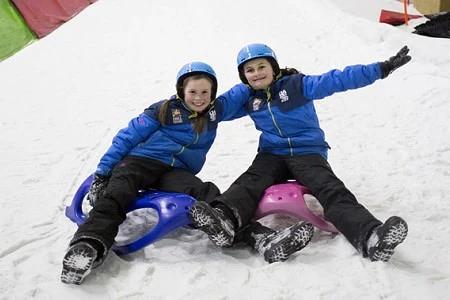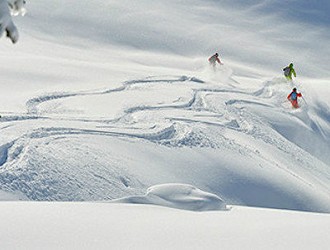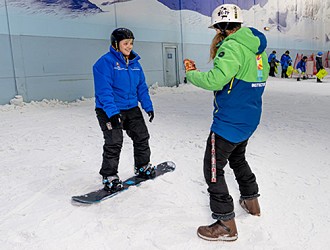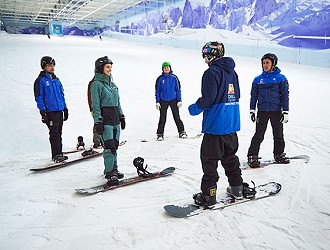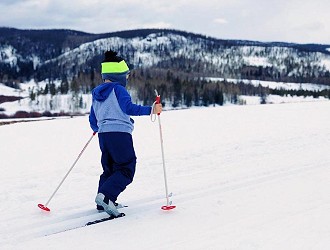Ski Terms: An A to Z Complete Guide
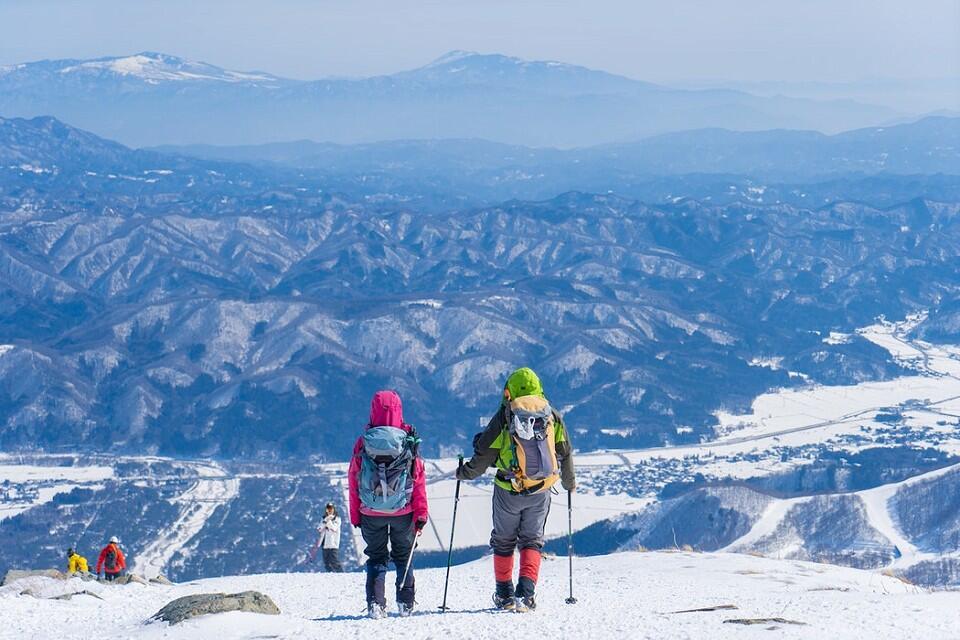
Have you ever been on the slopes, heard some ski terms for the first time and not been sure what they mean? We’ve all been there! That’s why Chill Factore has put together this A to Z guide of ski terms and the meaning of ski slang, so you can hit the slopes without the fear of being caught out.Make sure you pay attention to the list because there’s a test at the end (just kidding!).
Popular Ski Terms
A
- Aerials: Freestyle ski jumping involving flipping in the air.
- Air-to-Fakie: A half pipe trick where you approach the wall riding forward, no rotation is made in the air, and you land riding backwards.Alpine Skiing: Downhill as opposed to Nordic skiing or Telemark skiing.
- Apres-Ski: Time spent in the bar after a day of skiing.
- Artificial Snow: Man-made snow which is not as fine as real snow.
B
- Backside: This term originates in surfing and refers to riding the waves in a certain way. In snowboarding, it describes your direction of rotation when the rider spins clockwise in the air and their front foot is facing down the hill.
- Baseplate: A very important part of your bindings. The baseplate sits at the bottom of your bindings in contact with the ski or snowboard and transfers all of your movement into the ski or board.
- Biathlon: A cross country race that combines skiing and rifle shooting.
- Binding: The thing that connects your boot to your ski or snowboard. The bindings on skis are designed to release the boot in case of a fall. Snowboard bindings don’t automatically release.
- Black Run: An advanced level ski slope for excellent skiers and snowboarders.
- Blindside: An advanced rotation where vision is impaired during takeoff or landing and you must stretch to look over your shoulder.
- Blue Run: A gentle slope suitable for beginners. Recommended after taking a Beginner Lesson.
- Button Lift: A ski lift with a round plastic disc at the end of a long pole. The disc is placed between the legs and gently pulls skiers and boarders up the slopes.
C
- Cable Car: A large aerial lift that transports skiers and snowboarders up the slopes.
- Carving: Turns where the edges of the skis or snowboard are used.
- Carving Skis: Narrower skis designed for tight, clean turns.
- Chair Lift: An aerial ski lift that you sit on and rest your skis or snowboard on a bar.
- Cork: This is an off-axis spin where the rider’s head dips below the relative position of the board.
- Crevasse: A deep and sometimes hidden crack in a glacier.
- Cross-country Skiing: A discipline using narrow skis along flat tracks and gentle hills rather than ski slopes.
D
- DIN Settings: Means ‘Deutsche Industrie Normen’ in German. This is the tension release setting that determines at what pressure your binding releases the boot on a fall.
- Ding: A scratch or gouge in the base of the board, which can occur if you ride over a rock or hit a hard chunk of ice.
- Downhill Edge: The edge of the ski that is on the downhill side as you’re traversing the mountain.
- Downhill Ski: The ski that is on the downhill side as you traverse the slope.
- Drag Lift: A lift that simply pulls you up the slope as you stand on your skis or snowboard.
E
- Edge: This is the metal strip on the edge of the ski or snowboard that’s used for control while turning.
- Equipment: Refers to your skis, snowboard, boots and ski poles.
F
- Fakie: Skiing or snowboarding backwards.
- FIS: Means ‘Federation Internationale de Ski’, which is the international organisation of ski sports.
- Freestyle: A style of skiing or snowboarding that focuses on jumps, tricks and aerials. If you’re interested, you can read more about Freestyle at Chill Factore.
G
- Gate: A flag or pole in the snow that marks a racing area. Learn about Chill Factore’s Race Club.
- Goggles: Worn to protect your eyes against the sun, wind and glare.
- Gondola: An aerial lift that’s enclosed and is faster than an open chairlift.
- Grab: Grabbing hold of any part of your skis or snowboard while doing tricks and jumps. The most basic of all aerial stunts.
- Grooming: Where large piste basher machines flatten and smooth the snow on the slopes. Usually done throughout the night in most ski resorts.
H
- Halfpipe: A U-shaped channel with smooth walls used by freestyle skiers and snowboarders for aerial tricks.
- Hard Pack: Snow that has been compressed down as far as it will go, making it hard packed.
- Heli Skiing: Getting a lift from a helicopter to off-piste areas that are otherwise inaccessible to ski on fresh powder snow.
I
- Indy Grab: The most basic snowboarding grab. This is where you grab the toe edge of the snowboard with your rear hand while in the air.
- Inside Edge: The ski that is on the inside of a turn.
J
- Jib: Snowboard or ski across a non-snow surface like a rail or box.
K
- Kicker: A small, triangular shaped jump usually made of snow. We use these on our main slope at Chill Factore.
L
- Lift Pass: A lift pass is a ticket that allows you to use the ski lifts. Book your Lift Pass now to have access to the slopes at Chill Factore.
M
- Method Air: With both knees bent and the heels rising towards your back, the front hand grabs the heel edge and the board is pulled to the level of the head.
- Moguls: Moguls are bumps set out on a slope. They’re usually found on black runs and used by advanced skiers.
- Monoski: A type of ski with both boots attached to a single ski.
- Mute Grab: While in the air, grab the toe edge of the snowboard between the bindings with your front hand.
N
- Nordic Combined: A race that combines country skiing and ski jumping.
- Nordic Skiing: See cross-country skiing.
- Nose Bonk: To intentionally hit and rebound off of a natural or man-made object with the nose of the board.
O
- Off-Piste: A snowy area away from the marked ski slopes. Popular with freestyles and people that enjoy powder snow.
- Ollie: A jump or hop on skis or snowboard that can be done on the flat. A fundamental trick that we teach in out Freestyle Lessons.
- Outside Ski: The ski on the outside of a turn.
P
- Packed Powder: The perfect ski conditions where new snow has been groomed or ridden over to pack it down.
- Piste: The French word for ‘ski slope’.
- Piste Basher: A tracked vehicle used for grooming ski slopes to even out the snow and prepare the slopes for skiers.
- Powder: Fresh snow that hasn’t been packed down. Found off-piste or just after a heavy snowfall.
R
- Rail: A metal bar found on snow parks built to be used by freestyle skiers and snowboarders.
- Red Run: An intermediate level slope.
- Rope Lift: Usually found in beginner ski areas. This is a lift where you hold onto a slow moving rope which gently pulls you up the slope.
S
- Salopettes/Ski Pants: Warm, waterproof trousers designed for snow sports. Check out Chill Factore clothing options.
- Schussing: Skiing straight downhill without turning.
- Ski Area: The area of the mountain designated for skiers. Usually marked by flags or ropes at the edges of the slopes.
- Slalom: A downhill ski race between tightly-spaced gates that must be passed through with short, quick turns.
- Slope: A slope is an area of snowy hill that’s designated for skiers and snowboarders.
- Slush: Wet snow, or melting snow.
- Snow Cannon/Snow Machine: Machines on the slope that turn water into artificial snow.
- Snow Park: An area built especially for freestyle skiers and snowboarders, filled with jumps, rails, boxes and more.
- Snowplough: A beginner’s technique where the skis are held in a ‘V’ formation with the tips almost touching. It allows for slowing down and turning.
T
- T-Bar: There are two types of T-bar lifts: singles and doubles. With a single T-Bar lift, the bar goes between your legs and pulls you up the slopes. The double is shared with a friend and one half of the ‘T’ goes behind your bottom.
- Telemark Skiing: This is a combination of downhill and cross-country skiing. The skis have detached heels, but are still wide enough to handle fast speeds and sharp turns. Learn about our Telemark Sessions.
- Tips: The front end of the skis.
- Travelator/Magic Carpet: A conveyor belt-like lift where you stand on the lift and it carries you to the top of the slope. Usually found on beginner slopes and children’s areas.
- Traverse: Skiing across a slope in a zig-zag pattern rather than straight down.
U
- Uphill Edge: The edge of the ski that’s on the uphill side when traversing the slope.
- Uphill Ski: The ski that is on the uphill side as you traverse the slope.
W
- Wax: Used on the underside of skis and snowboards to help them glide smoothly over the snow.
- White Out: When visibility drops to almost nothing; caused by heavy snowfall, fog, or a combination of the two.
Lift Pass at Chill Factore
Now you know all the ski terms there are to know, you’re fully prepped for the slopes! Head down to Chill Factore, pick up a Lift Pass with your friends and put your boosted knowledge to the test.
Chill Factore is open seven days a week, so there’s plenty of opportunities to brush up on your skills and enjoy your time on the slopes.


